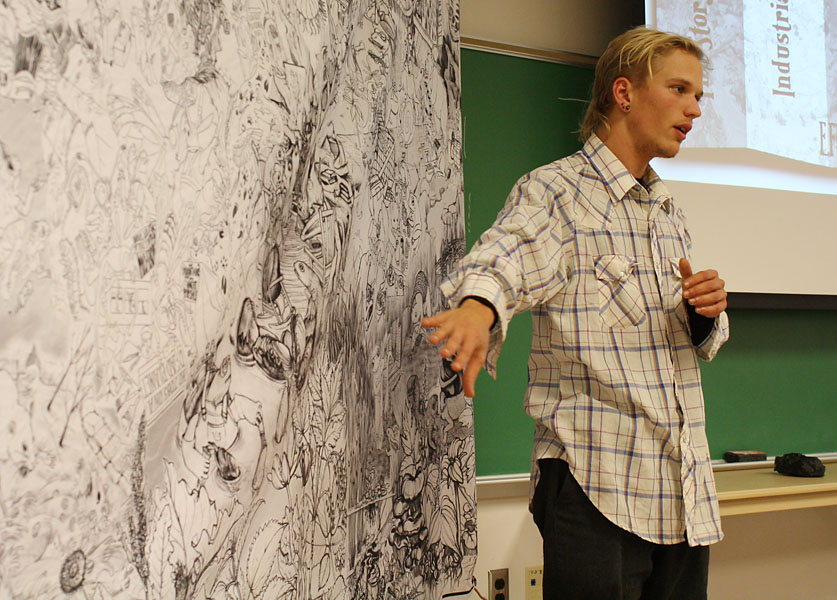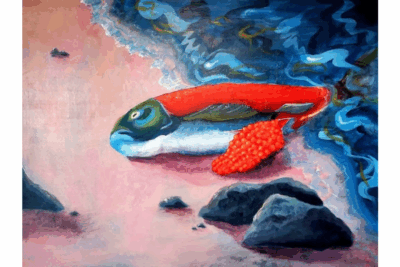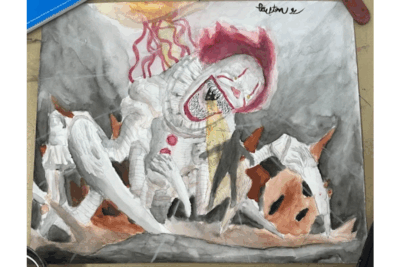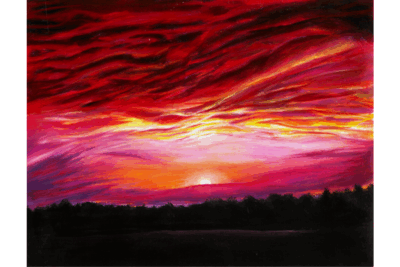On Friday, four busy bees gathered in an Umble Center classroom to show off a year’s worth of hard work; but instead of honey, the fruit of their labors was a massive black and white poster, and instead of flowers, their intended audience was an eager crowd of Goshen students and faculty.
These “bees” are members of The Beehive Design Collective, a 100% volunteer-driven, non-profit organization formed in 2000. The organization’s mission is to produce collaborative artwork that features images symbolic to current social and political issues. Since the artwork is non-copyrighted, it can be quickly distributed to schools and organizations. In other words, the Beehive uses art as a creative, straightforward facet for explaining complex yet crucial issues.The process of forming a Beehive design requires at least one year of cooperation and planning. First, a social issue is decided upon, often chosen by which topics are in popular demand. Next, ideas and sketches are formed through a massive group effort, as Bees talk to community members and hear about their personal experiences concerning the issue. Notes in form of a “mind map” are made so that every concept has a metaphor, and every metaphor a picture. Eventually each image is drawn in pencil by a group of Bees—which calls for cooperation and patience.
“We have really weird arguments!” joked Erin, one of the Beehive presenters, “Like, ‘What kind of hat should that bird wear?’”
When complete and covered in ink, the image can be copied and distributed locally, nationally and globally.
In the past, issues such as free trade, globalization and biotechnology have been depicted in Beehive artwork. Each image contains no human figures to avoid any risk of stereotyping. They also contain no language, which allows the pictures to be understood by many different cultures, especially those that may be illiterate. The Beehive has even traveled to Latin America to gather stories and share its images.
The Beehive’s current project is a graphic campaign called, “The True Cost of Coal.” Intricate black-and-white images are spread over a giant poster depicting the negative effects of mountaintop removal. When folded together, the poster shows an intact mountain with clean streams and native species. But when pulled apart, the poster shows what is actually happening: destruction of communities, deforestation, and loss of valuable resources. The sections tell stories of erosion, floods and pollution—results of removing mountaintops for coal mining.
When the story behind each poster is explained, it has the ability to empower one to want to bring about change. For this reason, the Beehive is linked closely with organizations and sponsors—they can refer viewers to the appropriate groups, allowing for more direct action. The hive’s recent stop at Goshen was just one of many as they continue to tour across the United States, sharing their work.
The Beehive Design Collective is located in Maine, but its membership is open and relaxed, so that anyone can help or participate.
“We are more of an organism, not an organization,” said Kehben, another Beehive presenter.
Currently the group is on tour exhibiting their coal project. For more information on the Bees, go to http://www.beehivecollective.org/english/front.html.



